The AMD Llano Notebook Review: Competing in the Mobile Market
by Jarred Walton & Anand Lal Shimpi on June 14, 2011 12:01 AM ESTPower Gating
With 1.45 billion transistors on die, Llano relies on extensive power gating in order to keep things in order. The APU is split into two independent power islands: the CPU and the GPU. The memory controller and North Bridge both live on the GPU's power island. Each island has its own independent voltage source.
Everything from an individual CPU core to the entire GPU or virtually the entire APU package can be power gated. AMD provided photon recombination images to show the impact power gating the GPU can have on leakage current:
Although not depicted above, Llano can also fully power gate the x86 CPU cores or both the CPU and GPU if the entire APU is in a deep sleep state. Being able to completely power gate CPU cores or the GPU is an important part of enabling the next major feature of Llano: Turbo Core.
Turbo Core
All processors whether CPUs, GPUs or APUs have to be designed to strict thermal and power limits. OEMs need to know exactly what sort of chassis they'll be able to build around these chips and as a result the chip vendors provide guidance in the form of specifications, including the chip's thermal design point (TDP).
In the old days of microprocessors things were simple. You had a single core that ran all the time and it consumed all of the available thermal budget allocated for that core. AMD and Intel eventually enabled dynamic clock frequencies which let your single core underclock itself when it wasn't being used, which helped reduce power and extend battery life. Then came the multi-core era.
CPUs couldn't just start putting out twice as much heat now that they had two cores; instead, each core had to consume less power. The chip guys achieved this by running the cores at lower frequencies and voltages than they did in the single-core days. Two cores paved the way to four cores, which meant another reduction in clock speed per core. Sure we got much better multi-threaded performance, but for single-threaded applications performance wasn't as great as it could be. Users had to make a tradeoff: good multi-threaded performance or good single-threaded performance; you couldn't have both. Until power gating came along that is.
Without power gating you can never really shut off power to an idle core. The transistors aren't switching but power is still dissipated thanks to leakage current. Remember that transistors don't simply stop conducting electricity when they're off. The smaller they get, the more leaky our beloved transistors become. Power gating lets you physically block the flow of current to the transistors that are being gated, so when they're off, they're actually off. With an idle core shut off, now you have the extra TDP headroom to run any active cores at higher frequencies.
Intel does this with a technology it calls Turbo Boost. Intel looks at current draw and thermal sensors spread out all over the chip and determines when it has the available thermal headroom to turbo up any active cores. AMD implements a similar technology in Llano (and previously in their hex-core desktop parts) called Turbo Core.
I say similar but not identical because AMD's approach differs in a very important way. While Intel looks at current draw and temperature data, AMD looks at workload. Each activity within the Llano APU is assigned a certain power weight (e.g. an integer multiply is known to require a certain amount of power). Llano is aware of the operations it's currently working on and based on the weights associated with these operations it comes up with a general estimate of its power consumption on a per core basis. I mention this is an estimate because it correlates digital activity to power consumption; it doesn't actually measure power consumption.
Based on the number of events and their individual weights, AMD estimates the power consumption of each core and determines how much TDP headroom exists in the system. If the OS is requesting the highest p-state from the CPU and there's available TDP headroom, Llano will turbo up any active cores up to a maximum frequency. Like Sandy Bridge, Llano is able to temporarily exceed the APU's maximum TDP if it determines that the recent history of power consumption has been low enough that it'll take a while for the APU to ramp up to any thermal limits.
One major limit of Llano's Turbo Core is that the GPU can't turbo up in the event of the CPU cores being idle. Only the CPU cores can turbo up if they have available headroom. I suspect future versions of Llano will probably enable GPU Turbo Core as well:
It's unclear to me at this point what shortcomings or advantages exist for AMD's Turbo Core method vs. Intel's Turbo Boost. At the bare minimum the two are finally comparable although they use different approaches to attain a similar end result. AMD doesn't yet have a method of actually displaying Turbo Core frequencies, unfortunately, so we're operating a bit blind at this point. Over time I hope to have a better idea of how AMD's solution stacks up.


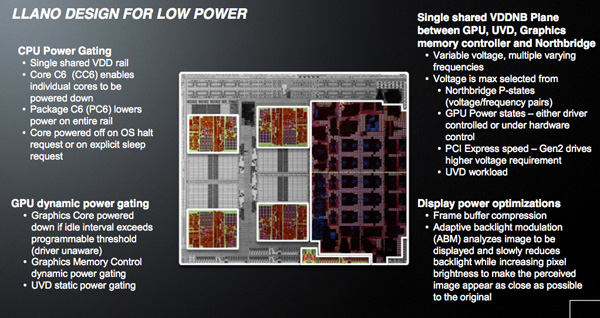
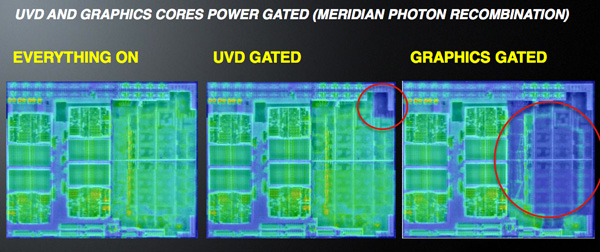
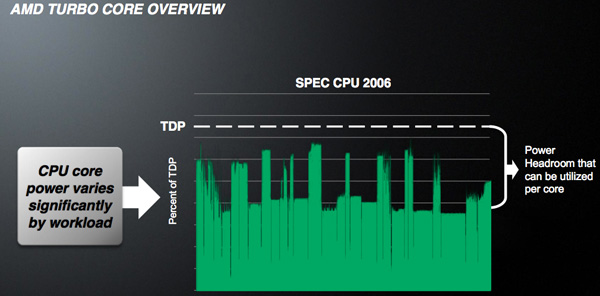
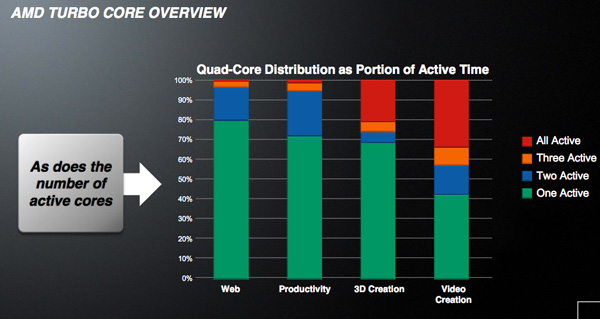
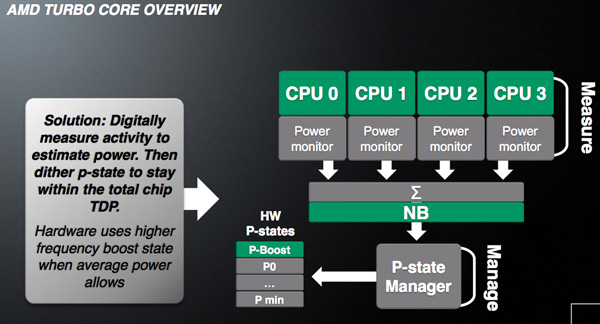
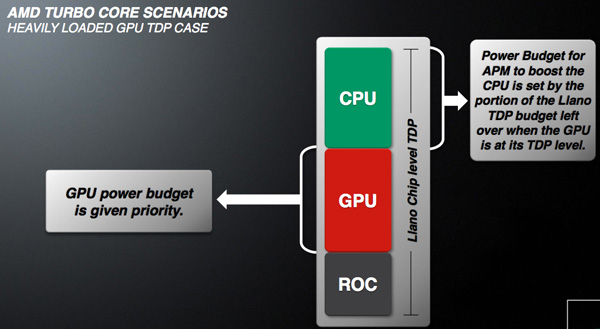
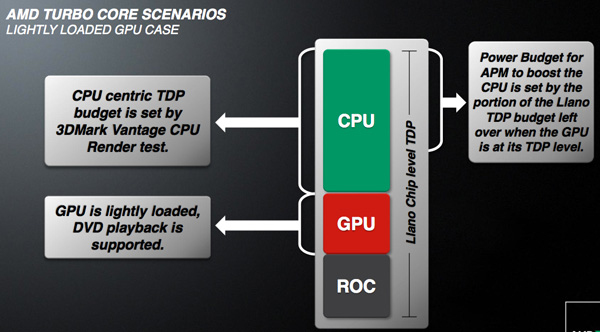








177 Comments
View All Comments
phantom505 - Tuesday, June 14, 2011 - link
I went with a K325 in a Toshiba with a Radeon IGP. Nobody I have lent it out to has every complained about it being slow or incapable of doing what they wanted/needed to. I get about 5 hours of battery life consistently. I don't do too much that is CPU intensive but I hear people moan and groan about the E-350 and Atom both when they try to open 50MB+ ppt files. I have no such problems.I for one an quite happy to see that AMD is still leading this segment since most users will be quite happy with AMD. I'm finding it more and more that Intel may own the top end, but nobody I know cares in the slightest.
mino - Tuesday, June 14, 2011 - link
E-350 is generally faster than K325 + IGP. Then than that, I fully agree.ash9 - Tuesday, June 14, 2011 - link
In this price range, I think not, besides Open(X) applications will reveal the potential - its up to the application developers nowGaMEChld - Tuesday, June 14, 2011 - link
My netbook is a pain to use precisely because of its graphics. It cannot properly play youtube or movie files fluently. Aside from its multi-media problems, I don't try to do ridiculous things on a netbook, so the other components are not much of a factor for me. But if I can't even watch videos properly, then it's trash.Luckily, I got that netbook for free, so I'm not that sad about it. I'll probably sell it on eBay and get a Brazos netbook at some point.
hvakrg - Tuesday, June 14, 2011 - link
Yes, they're becoming primary machines, but what exactly do you need the CPU part for in a primary machine today? Let's face it most people use their computer to browse the web, listen to music and watch videos, all of which are either relying on the GPU today or is clearly moving in that direction.Intel will have an advantage in the hardcore CPU market probably forever due to them being years ahead of the competition in manufacturing processes, but what advantage does that give them when it comes to selling computers to the end user? Things like battery life and GPU performance is what will be weighted in the future.
Broheim - Wednesday, June 15, 2011 - link
personally I need it to compile thousands of lines of code sometimes several times a day, if I were to settle for a E-350 I'd die of old age long before I get my masters in computer science.... some of us actually gives our 2600k @ 4.5ghz a run for it's money.th G in GPU doesn't stand for General... the GPU can only do a few highly specialized tasks, it's never going to replace and will always rely on the CPU. Unless you're a gamer you benifit much more from a fast CPU than a fast GPU, and even as a gamer you still need a good CPU.
don't believe me? take a E-350 and do all the things you listed, then strap a HD6990 onto it and try and see if you can tell the difference...
trust me, you can't.
ET - Wednesday, June 15, 2011 - link
Compiling code is a minority application, although I did that at a pinch on a 1.2GHz Pentium M, so the E-350 would do as well. Certainly won't use it for my main development machine, I agree.Still, as hvakrg said, most users do web browsing, listen to music, watch video. The E-350 would work well enough for that.
sinigami - Wednesday, June 15, 2011 - link
>most users do web>browsing, listen to music,
>watch video. The E-350
>would work well enough
>for that.
The Atom also works well enough for that, for less money.
You might be pleasantly surprised to find that current Atom netbooks can play 720p MKVs. For netbook level video, that's "well enough".
As you said, for anything tougher than that, i wouldn't use it for my "main machine" either.
ionave - Thursday, June 16, 2011 - link
Why would you spend $2000 for an intel powered laptop when you can build a desktop to do computations for a quarter of the price at 20x the speed, and get a laptop for $400 to run code on the desktop remotely and use it for lighter tasks? I'm surprised that you are a masters student in computer science, because your lack of logic doesn't reflect it. Correct me if I'm wrong, but why would you compute on the go when you can let the code on a desktop or cluster while the laptop is safely powered down in your backpack?Also, I can run Super Mario Galaxy using dolphin (CPU intensive) emulator at full frame rate on my AMD Phenom II X2 BE, and the cores in the A8 are improved versions of Phenom II X4. You really need to get your facts straight, since the CPU is actually VERY good. Go look at the benchmarks and do your research
Broheim - Thursday, June 16, 2011 - link
he clearly said primary machine, so before you go around insulting me I'd suggest you learn how to read.the 2600K is a desktop CPU you douchebucket, I never said my main machine was a laptop, quite to the contrary.
what you can and can't do is of no interrest to me, but first off, I never mentioned the A8 I said E-350, again with the failure to read.
nevertheless...
K10 is not even a match for Nehalem, and so far behind Sandy bridge it's ridiculous.
I've seen the benchmarks, I've done my research and concluded that the A8 CPU is far from "VERY" good, have you done yours?